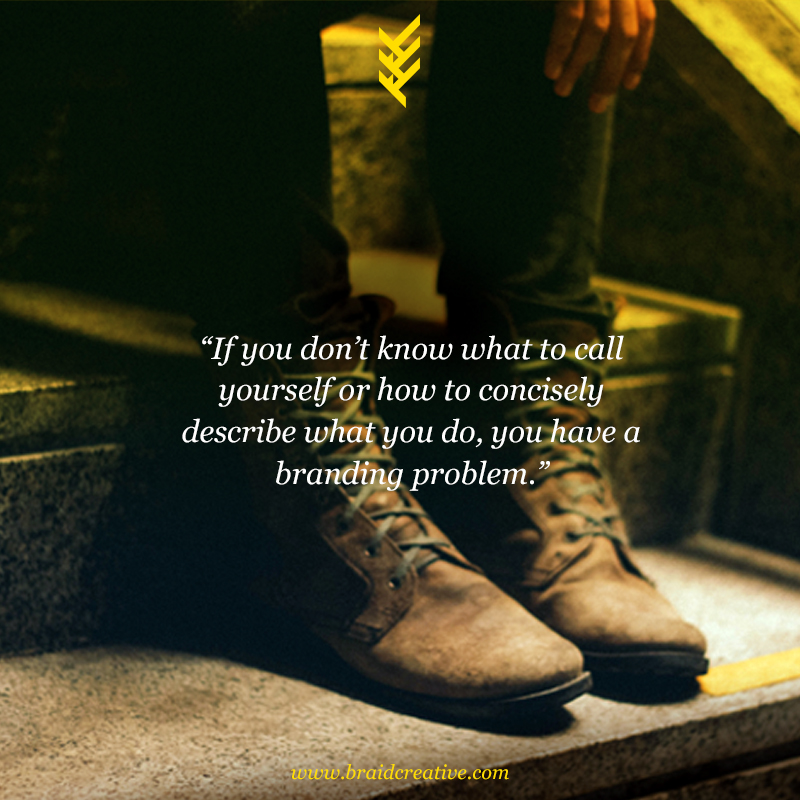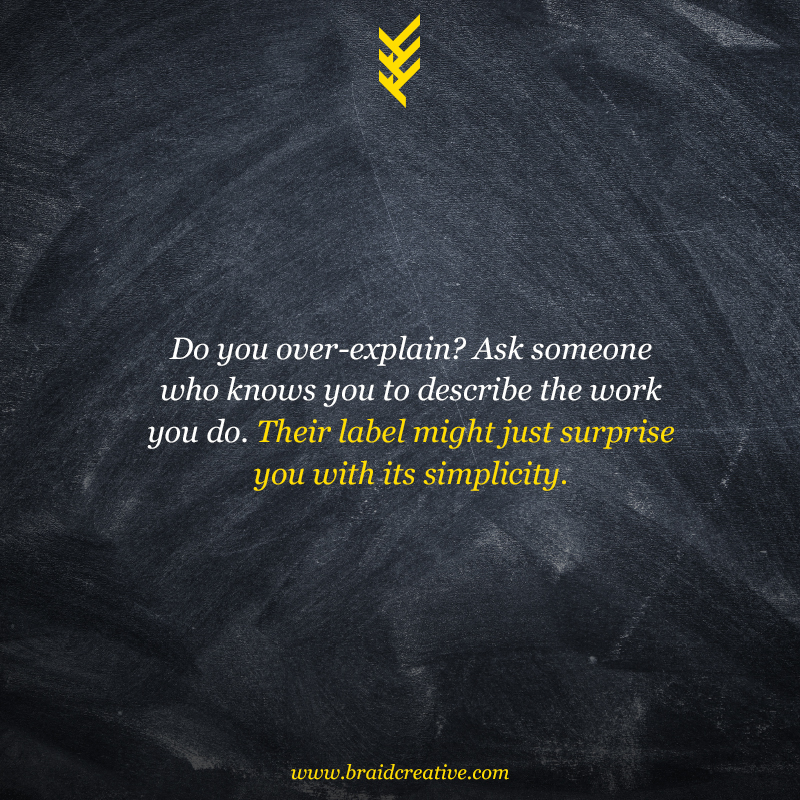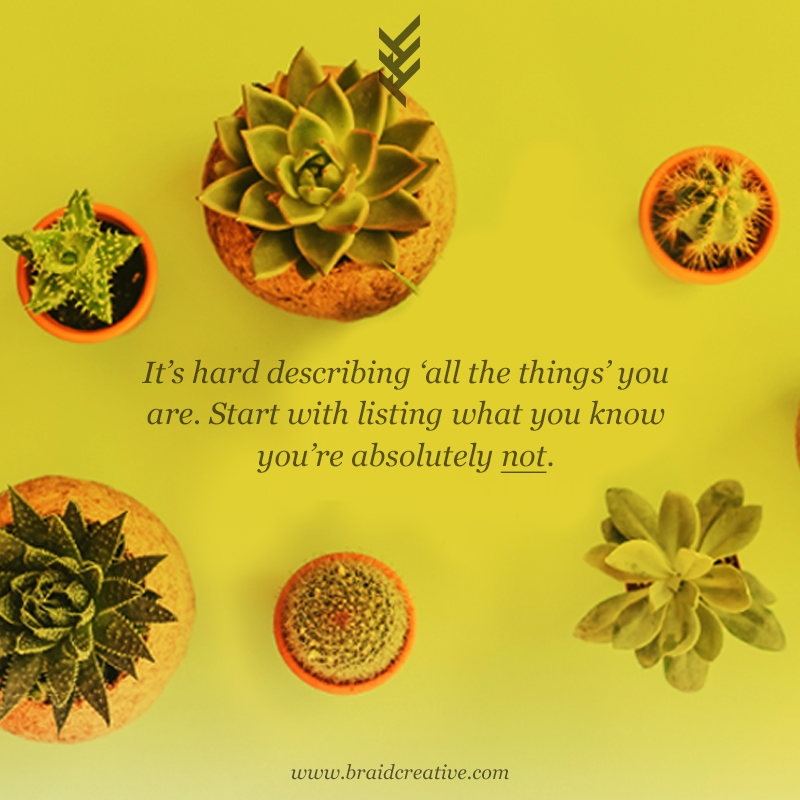Kathleen here thinking about how it’s so hard for creatives to describe what they do in just one or two words. I’ve been there! I wear a lot of hats: co-owner, designer, writer, brand strategist, podcaster, coach, consultant, and speaker – just to name a few. So it’s really hard to sum up what I do in just one or two words.

If you don’t know what to call yourself or how to concisely describe what you do, you have a branding problem.
Because when you don’t know how to concisely describe what you do, your potential clients will feel confused as to how they can hire or engage with you, your existing customers will have a hard time referring you to their friends, and search engines will have a hard time recommending you to people who are looking for the skills you possess.
SAY IT IN THE SIMPLEST WAY
One of the easiest ways to say what you do is to first think about someone familiar with your work. Then ask “how would they describe what I do?”
So I just literally asked my husband how he describes what I do to his co-workers, for example, to see how he simplifies what I do. He said “branding consultant and podcaster.”

Do you over-explain? Ask someone who knows you to describe the work you do. Their label might just surprise you with its simplicity.
Now, once you are able to say what it is you do, you can then follow up with all the ways you are different or “more than just” whatever your title is.
But for now – if you’re a web developer, call yourself a web developer. If you’re a brand strategist, call yourself that. If you are a life coach, call yourself a life coach.
HOW DO YOUR CLIENTS DESCRIBE YOU?
One of the Braid Method branding exercises we take our clients through asks them to pretend they’re eavesdropping on a conversation in a coffee shop—let’s say, between a client and their friend—and imagine this client talking about the experience they had working with you:
- How does your client describe what you do?
- What kinds of clarifying questions does the friend ask about you?
- What does your client say is different about you?
- What was their favorite part about working with you?
When you imagine this conversation, think about the specific words, benefits, and objections that are coming up. This will help you with your own positioning.
Here are a few fill-in-the-blanks to get you started on this exercise:
“Oh I just love _____ because of the way she _____.”
“She’s not just a _______ she’s more like a _______.”
“You might think she’s a _______ but she’s also a ______.”
“I don’t think she understands how amazing she is at _______.”
“She not only helped me _____ but also really gave me _____.”
DEFINE WHAT YOU ARE BY SAYING WHAT YOU AREN’T
One of our other favorite ways of getting to the heart of what you are is clarifying what you aren’t. This is especially useful in industries or titles that include a lot of different functions.
So for example, let’s say you’re a web developer. Some people might think that includes branding, writing, strategy, SEO, social media, and ongoing maintenance. Do you actually do all those things?

“It’s hard describing ‘all the things’ you are. Start with listing what you know you’re absolutely not.”
Try this branding exercise: a line in the sand. Draw a line down the middle of a piece of paper. On the left hand side write “I AM” and on the right hand side write down “I AM NOT”. Make a laundry list of all the things you do and don’t do accordingly. (Bonus! You can also include personality traits on this list.)
Now, is there anything on the “I AM NOT” side that you get asked to do all the time? Or is there anything on the “I AM” side that you feel like you aren’t getting enough attention or credit for? If so, this is a branding and positioning problem. You might need to get more clear about how you describe what you do, clarify your offering, or even make a shift in the customer you’re trying to target with your offer.
Okay! Now that you have a little more clarity around what to call yourself and what you do (and what you don’t do), you’ll want to do inventory on all the places your brand exists and make sure you are clearly saying what you mean in all those places:
- your “about me” web page
- your “offerings / how to hire me” web page
- your social media profiles
- any networking sites you’re a part of
- your business cards and any other print materials
- and last, but not least: your conversations
CONTEXT MATTERS
If you’re having a hard time committing to the simple job title or description you’ve given yourself, I feel you. So here’s where I want to tell you that context matters. The design of your website, your own personal style, and the words you say before and after you introduce yourself online and offline will all play into how someone perceives your brand and what you do. So as you’re doing inventory on your words you might think about what the rest of your brand says about you too.
Did you find this exercise helpful? Be sure you’re signed up for our Letters for Creatives for more tips and exercises in your inbox. Plus! We’ll be holding monthly webinars to share more branding tips + exercises with you live. More details and sign up information will go out in our newsletter, so make sure you’re on the list to stay up to date!
LETTERS for CREATIVES
Thank you for signing up for our Braid Letters. Keep your eyes peeled on your inbox and in the meantime like us on Facebook.

